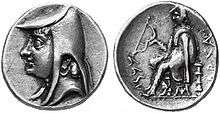Arsaces I of Parthia
| Arsaces | |
|---|---|
| King of the Arsacid dynasty | |
 Coin of Arsaces I. The reverse shows a seated archer carrying a bow. A Greek inscription on the right reads ΑΡΣΑΚ[ΟΥ] (from the outside). The inscription below the bow is in Aramaic. | |
| Reign | ca. 250 BC to either 246 BC or 211 BC |
| Successor | Arsaces II |
| Died | 246 BC or 211 BC |
| Dynasty | Arsacid dynasty |
Arsaces I (/ˈɑːrsəsiːz/; Persian: ارشک ٫ اشک یکم Arshak, Greek: Ἀρσάκης,) was the founder of the Arsacid dynasty of Parthia, and after whom all 30+ monarchs of the Arsacid empire officially named themselves. A celebrated descent from antiquity (the Bagratid "line") begins with Arsaces.[1] Arsaces or Ashk has also given name to the city of Ashkabad.
Origin
The dates of Arsaces' birth and death are unknown, as is his real name. Most scholars now believe that Arsaces was a chief of the Parni, a Dahae tribe who conquered Parthia shortly before Diodotus’ revolt.[2] [3] [4] It should be noted, however, that there is no agreement among classical sources regarding his origins, and doubt about the accuracy of classical and traditional sources on the matter.[5] Moreover, even the most respected and/or frequently cited sources regarding Arsaces are later reiterations of classical sources, such as Arrian (i., preserved in Photius and Syncellus) and Strabo (xi.)
Rival theories about the origins of Arsaces and/or the Parni Dahae include:
- several cited by Strabo, including
- a suggestion, which Strabo doubts, that the Dahae (including the Parni) were "Scythians", who had earlier migrated from "above the Maeotis" (Azov Sea),
- evidence that Arsaces may have originated in Bactria,[6] and
- a claim that Arsaces, rejecting the increasing power of Diodotus, himself led the revolt of Parthia;[7]
- classical accounts claiming that the "Persian" Andragoras, whom Alexander left as satrap of Parthia, was the ancestor of the subsequent kings of Parthia, such as Arsaces.[8]
- Arrian, in Parthica – a now-lost work, epitomized by Photius's Bibliotheca (58) and the 12th century Syncellus [9] – suggests that Arsaces and Tiridates were brothers, and descendants of Phriapites;
- conversely, according to Syncellus, the brothers Arsaces and Tiridates may have been descendants of the Persian Achaemenid king Artaxerxes II,[10] and;
- attempts to link Arsaces to Kai Kobad (Kay Qobád), a mythological king of the Kayanian dynasty.[11][12]
Reign
In contrast, the circumstances of Arsaces' ascent to power are relatively well known. Around 250 BC, Andragoras, the governor of the Seleucid province of Parthia, proclaimed his independence from the Seleucid monarchs, and made his governorate an independent kingdom. At about the same time, Arsaces was elected leader of the Parni, an eastern Iranian tribe. With the Parni, Arsaces seized Astauene (or Astabene), i.e., northern Parthia. Andragoras was killed during his attempts to recover it, which left the Parni in control over the rest of Parthia as well. A recovery expedition by the Seleucids under Seleucus II did not succeed, and Arsaces and the Parni succeeded in holding Parthia proper during Arsaces' lifetime. (Arsaces II lost it in 209 BC to Antiochus III, to whom the Arsacids became vassals for the next 25 years).
The line of succession is unclear, since his successors adopted the name Arsaces as well, making it difficult to distinguish them from the founder of the dynasty. From legend and secondary accounts, it seems that—at least from 246 BC onwards—Arsaces' brother Tiridates I either ruled in Arsaces' name or co-ruled with him. Then, after 211 BC, when another Arsaces is seen on coinage, either the brother ruled as Arsaces II, or Arsaces II was Arsaces' son (or nephew). Other combinations, e.g. that Tiridates killed his brother (as said by the later Arrian), have also been suggested.
Arsaces issued coins from silver drachmas to copper dikhakloi. All issues bear some similarity in style to the Seleucid pieces of the same time, although the headdress on the Parthian coinage is notably different. The commonest inscription is ΑΡΣΑΚΟΥ ΑΥΤΟΚΡΑΤΟΡΟΣ, translating as Arsaces the Autocrat, however there are many variations on this.
Notes
- ↑ A 1st century AD tradition (preserved by Arrian) casts Arsaces as descending from the 5th-century BC Achaemenid monarch Artaxerxes II. The Seleucids (and virtually everyone else after them) propagated the same myth, and such contrived genealogies were used as a justification of the right to rule.
- ↑ http://www.iranicaonline.org/articles/arsacids-index
- ↑ Strabo, 11.9.2
- ↑ The History Of Ancient Iran Richard N. Frye, pp. 205-208
- ↑ History of Ancient Iran, Hassan Pirnia pp. 2197–2203.
- ↑ Strabo 11.9.3
- ↑ Strabo 11.9.3
- ↑ Justin 12.4.12
- ↑ Corpus scriptorum historiae Byzantinae XIII, ed. W. Dindorf, Bonn, 1829, p. 539.
- ↑ Justin 12.4.12
- ↑ Ferdowsī. Šāh-nāma VII. p. 116
- ↑ Ṭabarī, I, p. 710
References
- Bivar, A.D.H. (1983), "The Political History of Iran under the Arsacids", in Yarshater, Ehsan, Cambridge History of Iran 3.1, London: Cambridge UP, pp. 21–99, esp. p. 31.
- Józef Wolski, 'Arsace II et le genealogie des premiers arsacides', Historia XI (1962), 138-45.
- Józef Wolski, 'Arsaces I:założyciel państwa partyjskiego' (Arsaces I: Founder of the Parthian state), part 1, Eos, (1937), vol. 38, p. 492-511 & part 2, Eos, (1938), vol. 39, p. 244-266
- http://www.iranicaonline.org/articles/arsacids-index
- (Strabo 11.9.3), (Strabo, 11.9.2), (Justin 12.4.12)
- The History of Ancient Iran Richard N. Frye 1983, part of Expansion Of Kingdom, pp. 205–208
- History of Ancient Iran Hassan Pirnia pp. 2197–2203 part of parthia, Ashkanina
- (Corpus scriptorum historiae Byzantinae XIII, ed. W. Dindorf, Bonn, 1829, p. 539)
- (Ferdowsi. Šāh-nāma VII. p. 116), (tarikhe tabari History of the Prophets and Kings VI, p. 710)
| Arsaces I of Parthia Born: Unknown Died: 211 BC | ||
| Preceded by Andragoras |
King of Parthia c. 250–211 BC with Tiridates? (c. 246–211 BC) |
Succeeded by Arsaces II |